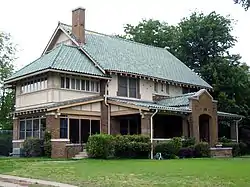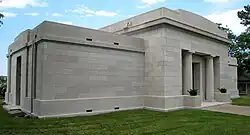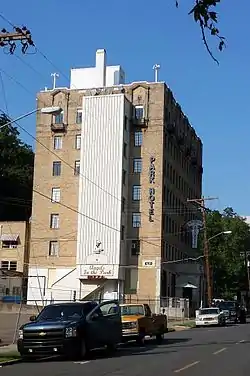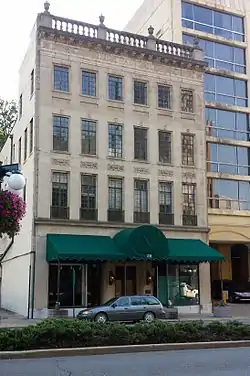Charles L. Thompson and associates
Charles L. Thompson and associates is an architectural group that was established in Arkansas since the late 1800s. It is now known as Cromwell Architects Engineers, Inc.. This article is about Thompson and associates' work as part of one architectural group, and its predecessor and descendant firms, including under names Charles L. Thompson, Thompson & Harding, Sanders & Ginocchio, and Thompson, Sanders and Ginocchio.


.jpg.webp)
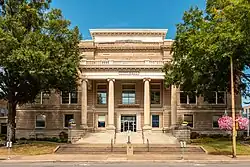
The firm was the "most prolific architectural firm" practicing in Arkansas in the late 1800s and early 1900s, and produced more than 2,000 buildings. The architectural group used standard and custom designs that both led and evolved with changing architectural taste in Arkansas. The group built a wide range of types of works, including large public buildings, commercial buildings, mansions, and small houses. Many works by Thompson and the associated firms survive and are listed on the National Register of Historic Places.[2]
Charles L. Thompson
Charles Louis Thompson (16 November 1868 – December 30, 1959)[3] was the original head of the firm. Thompson was born in 1868 in Danville, Illinois. Orphaned at age fourteen, he and siblings moved to Indiana, where Charles began work at a mill, and in off hours began to learn drafting.[3] Thompson's son-in-law, Edwin Boykin Cromwell (1909–2001) later headed the firm.[4]
Thematic Resources study
A total of 143 properties in thirty Arkansas counties were nominated for NRHP listing in the 1982 study, "Charles L. Thompson Design Collection Thematic Resources", written by multiple authors. F. Hampton Roy, a Little Rock ophthalmologist, began cataloging the architectural drawings, expecting to complete a book. His collection eventually inspired this study, as Thompson and associates had such influence on Arkansas architecture. The properties listed under this study were selected from review of a large collection of original drawings by Charles L. Thompson, Fred J. H. Rickon, Thomas Harding Jr., Theo Sanders, and Frank Ginocchio. The collection of drawings covered 2500 properties representing a wide range of types and styles geographically distributed over the entire state of Arkansas. The authors wrote: "The 143 structures selected for nomination exemplify the firm's remarkable versatility and productivity from 1896 through 1931," and "Charles L. Thompson was the constant motivating force behind the firm's immense productivity and influence upon the state's built environment. Today the firm he established continues this legacy."[5]
Ginocchio and Sanders
Frank Ginocchio and Theodore M. Sanders, partners since 1919, joined Thompson in partnership in 1927. Both had studied at the University of Illinois and Sanders had studied further at the Ecole des Beaux Arts in Paris. They brought design ideas of Prairie Style, influenced by Frank Lloyd Wright, and Art Deco architecture to the firm.[5]
Theo Sanders designed several houses in Little Rock's Hillcrest neighborhood.[6]
Others
Architect John Parks Almand worked for the firm during 1912 to 1914 before forming his own practice.
Works
Works (with variations in attribution indicated) include:
- Al-Amin Temple, Little Rock, Arkansas, Prairie style, added to the NRHP in 1982 and removed from NRHP in 1986,[5]: 5, 45
- Associate Reformed Presbyterian Church, 3323 W. 12th St., Little Rock, Arkansas (Thompson, Charles L.), built 1925, Classical Revival, NRHP-listed[2]
- Baer House, 1010 Rock St., Little Rock, Arkansas (Thompson, Charles L.), built 1915, Bungalow/Craftsman, NRHP-listed[2]
- Bank of Carthage, (1907), AR 229, Carthage, Arkansas (Thompson, Charles L.), built 1907, Classical Revival, NRHP-listed[2]
- Bethel House, Erwin and 2nd Sts., Des Arc, Arkansas (Thompson, Charles L.), built 1918, Bungalow/Craftsman, NRHP-listed[2]
- Beyerlein House, 412 W. 14th St., Little Rock, Arkansas (Thompson, Charles L.), built 1917, Bungalow/Craftsman, NRHP-listed[2]
- Bishop Hiram A. Boaz House, 22 Armistead Rd., Little Rock, AR (Thompson, Charles L.), built 1926, Tudor Revival, NRHP-listed[2]
- Boone County Courthouse, Courthouse Sq., Harrison, AR, (Thompson, Charles L.) NRHP-listed[2]
- Boone County Jail, Central Ave. and Willow St., Harrison, AR (Thompson, Charles L.) NRHP-listed[2]
- Boone House (Little Rock, Arkansas), 4014 Lookout, Little Rock, AR (Thompson & Harding) NRHP-listed[2]
- BPOE Elks Club (Little Rock, Arkansas), 4th and Scott Sts., Little Rock, AR (Saunders, Theo), Late 19th and 20th Century Revivals, 2nd Renaissance Revival, Theo Saunders was an architect in the firm, and this work was specifically included in the Thematic Resources listing,
- Brown House, 1604 Caldwell St., Conway, AR (Thompson, Charles L.) NRHP-listed[2]
- Bush House, 1516 Ringo St., Little Rock, AR (Thompson & Harding) NRHP-listed[2]
- Caldwell Hall, University Drive, Pine Bluff, AR (Thompson, Sanford, & Ginnochio) NRHP-listed[2]
- Campbell-Chrisp House, 102 Elm St., Bald Knob, Arkansas (Thompson, Charles)
- Ella Carnall Hall, Arkansas Ave. and Maple St., Fayetteville, AR (Thompson, Charles L.) NRHP-listed[2]
- Central Presbyterian Church, 1921 Arch St., Little Rock, AR (Thompson & Harding) NRHP-listed[2]
- Christ the King Church, Greenwood Ave. at S. S St., Ft. Smith, AR (Thompson, Sanders & Ginocchio), built 1930, Mission/Spanish Revival, NRHP-listed[2]
- Clark County Courthouse, 4th and Crittenden Sts., Arkadelphia, AR (Thompson, Charles), built 1899 in Romanesque style, NRHP-listed[2]
- Clark County Library, 609 Caddo St., Arkadelphia, AR (Thompson, Charles L.) NRHP-listed[2]
- Clark House, 1324 S. Main St., Malvern, AR (Thompson, Charles L.) NRHP-listed[2]
- Coca-Cola Building, (1929), 211 N. Moose, Morrilton, AR (Thompson, Sanders & Ginocchio) built 1929, Colonial Revival and Modern Movement, NRHP-listed[2]
- Columbia County Jail, Calhoun & Jefferson Sts., Magnolia, AR (Thompson & Harding) NRHP-listed[2]
- Croxson House, 1901 Gaines St., Little Rock, AR (Thompson, Charles L.) NRHP-listed[2]
- Darragh House, 2412 Broadway, Little Rock, AR (Thompson, Charles L.) NRHP-listed[2]
- Davis House, 212 Fulton St., Clarksville, AR (Thompson, Charles L.) NRHP-listed[2]
- Dean House, (c.1910), off US 165, Portland, AR (Thompson, Charles) NRHP-listed[2]
- Deener House, 310 E. Center Ave., Searcy, AR (Thompson, Charles L.) NRHP-listed[2]
- Domestic Science Building, 11th and Haddock, Arkadelphia, AR (Thompson & Harding) NRHP-listed[2]
- Dortch Plantation, NE of Scott off AR 130 at Bearskin Lake, Scott, AR (Thompson, Charles L.) NRHP-listed[2]
- Dunaway House, 2022 Battery, Little Rock, AR (Thompson, Charles L.) NRHP-listed[2]
- Dunlap House, 101 Grandview, Clarksville, AR (Thompson, Charles L.) NRHP-listed[2]
- Eagle House, 217 Ash St., Lonoke, AR (Thompson, Charles) NRHP-listed[2]
- Joe P. Eagle and D. R. Boone Building, 105–107 W. Front St., Lonoke, AR (Thompson, Charles L.) NRHP-listed[2]
- England House, 2121 Arch St., Little Rock, AR (Thompson, Charles L.) NRHP-listed[2]
- Exchange Bank Building, 423 Main St., Little Rock, AR (Thompson & Harding) NRHP-listed[2]
- Farmers State Bank, 1001 Front St., Conway, AR (Thompson & Harding) NRHP-listed[2]
- Farrell House (2109 Louisiana), Little Rock, AR (Thompson, Charles L.) NRHP-listed[2]
- Farrell House (2111 Louisiana), Little Rock, AR (Thompson, Charles L.) NRHP-listed[2]
- Farrell House (2115 Louisiana), Little Rock, AR (Thompson, Charles L.) NRHP-listed, Bungalow/Craftsman style, built 1914[2]
- Farrell House (2121 Louisiana), Little Rock, AR (Thompson, Charles L.) NRHP-listed[2]
- Federal Reserve Bank Building, 123 W. Third St., Little Rock, AR, NRHP-listed[2]
- First National Bank of Morrilton, (c. 1925), Main at Moose St., Morrilton, AR (Thompson, Charles L.) NRHP-listed[2]
- First Presbyterian Church (Hot Springs), 213 Whittington, Hot Springs, AR (Thompson, Charles L.) NRHP-listed[2]
- First Presbyterian Church (Little Rock), 123 E. Eighth St., Little Rock, AR (Thompson, Charles) NRHP-listed[2]
- First Presbyterian Church (Newport, Arkansas), 4th and Main Sts. Newport, AR, (Sanders & Ginocchio), NRHP-listed[2]
- First United Methodist Church, Jct. of Jefferson and Cross Sts., DeWitt, AR (Thompson & Harding) NRHP-listed[2]
- Fletcher House, 909 Cumberland St., Little Rock, AR (Thompson, Charles L.) NRHP-listed[2]
- Florence Crittenton Home, 3600 W. 11th St., Little Rock, AR (Thompson & Harding) NRHP-listed[2]
- Fordyce Home Accident Ins. Co., (1908), 300 Main, Fordyce, AR (Thompson, Charles L.) NRHP-listed[2]
- Fordyce House (Hot Springs), 746 Park Ave., Hot Springs, AR (Thompson, Charles L.) NRHP-listed[2]
- Fordyce House (Little Rock), 2115 S. Broadway, Little Rock, AR (Thompson, Charles L.) NRHP-listed[2]

- Foster House, 303 N. Hervey St., Hope, AR (Thompson, Charles L.) NRHP-listed[2]
- Frauenthal House (Little Rock), 2008 Arch St., Little Rock, AR (Thompson & Harding) NRHP-listed[2]
- Fraunthal House, 631 Western, Conway, AR (Thompson, Charles L.) NRHP-listed[2]
- Frauenthal & Schwarz Building, 824 Front St. Conway, AR (Sanders & Ginocchio), NRHP-listed[2]
- French-England House, 1700 Broadway, Little Rock, AR (Thompson, Charles L.) NRHP-listed[2]
- Galloway Hall, Hendrix College campus, Conway, AR (Thompson, Charles) NRHP-listed[2]
- Gazzola and Vaccaro Building, 131-133 W. Cypress Brinkley, AR (Thompson, Charles L.) NRHP-listed[2]
- Gracie House, Off AR 88, New Gascony, AR (Thompson and Harding) NRHP-listed[2]
- Gregg House, 412 Pine St. Newport, AR (Sanders & Ginocchio), NRHP-listed[2]
- Hall House, 32 Edgehill, Little Rock, AR (Thompson, Sanders, & Ginocchio) NRHP-listed[2]
- Hardy House, 2400 Broadway, Little Rock, AR (Thompson and Harding) NRHP-listed[2]
- Hemingway House (Little Rock), 1720 Arch St., Little Rock, AR (Rickon & Thompson) NRHP-listed[2]
- Hemingway House and Barn (Fayetteville), 3310 Old Missouri Rd., Fayetteville, AR (Thompson, Charles L.) NRHP-listed[2]
- Ida Hicks House, 410 W. Arch St., Searcy, AR (Thompson, Charles L.) NRHP-listed[2]
- Healey and Roth Mortuary Building, 815 Main, Little Rock, AR (Sanders & Ginocchio), NRHP-listed[2]
- Hospital and Benevolent Association, 11th and Cherry, Pine Bluff, AR (Thompson, Charles L.), NRHP-listed on December 22, 1982 with reference number 82000841. Removed from NRHP, January 25, 2010[2] (which happens usually after a building has been demolished).
- Hot Spring County Courthouse, 210 Locust St., Malvern, AR (Thompson, Sanders,& Ginnochio) NRHP-listed[2]
- Hotze House, 1619 Louisiana St., Little Rock, AR (Thompson, Charles L.) NRHP-listed[2]
- Howson House, 1700 S. Olive St., Pine Bluff, AR (Thompson & Harding) NRHP-listed[2]
- Hudson House, 304 W. 5th St., Pine Bluff, AR (Thompson, Charles L.) NRHP-listed[2]
- Immaculate Heart of Mary Church, N of North Little Rock off AR 365, North Little Rock, AR (Thompson, Sanders & Ginocchio) NRHP-listed[2]
- Interstate Orphanage, (1928), 339 Combs, Hot Springs, AR (Thompson, Sanders, and Ginocchio) NRHP-listed[2]
- Johnson House (514 E. 8th St.), Little Rock, AR (Thompson, Charles L.) NRHP-listed[2]
- Johnson House (516 E. 8th St.), Little Rock, AR (Thompson, Charles L.) NRHP-listed[2]
- Johnson House (518 E. 8th St.), Little Rock, AR (Thompson, Charles L.) NRHP-listed[2]
- Johnson House (Pine Bluff), 315 Martin St., Pine Bluff, AR (Thompson, Charles L.) NRHP-listed[2]
- Katzenstein House, 902 W. 5th St., Pine Bluff, AR (Thompson, Charles L.) NRHP-listed[2]
- Keith House, 2200 Broadway, Little Rock, AR (Thompson, Charles L.) NRHP-listed, built 1912 in Prairie School, Bungalow/Craftsman style[2]
- Kittrell House, 1103 Hickory St., Texarkana, AR (Thompson, Charles L.) NRHP-listed[2]
- Lightle House, 605 Race Ave., Searcy, AR (Thompson, Charles L.) NRHP-listed[2]
- Little Rock Boys Club, 8th & Scott Sts., Little Rock, AR (Thompson, Sanders, and Ginocchio) NRHP-listed[2]
- Little Rock Central Fire Station, 520 W. Markham St., Little Rock, AR (Thompson, Charles) NRHP-listed[2]
- Little Rock City Hall, 500 W. Markham St., Little Rock, AR (Thompson, Charles) NRHP-listed[2]
- Lloyd England Hall, Jct. of Missouri Ave. and 6th St., NW corner, North Little Rock, AR (Thompson, Sanders, and Ginocchio) NRHP-listed[2]
- Lo Beele House, 312 New York Ave., Brinkley, AR (Thompson, Charles L.) NRHP-listed[2]
- Mann House, 422 Forest St., Forrest City, AR (Thompson, Charles L.) NRHP-listed[2]
- Marshall House, 2009 Arch St., Little Rock, AR (Thompson, Charles L.) NRHP-listed[2]
- Martin Hall, Hendrix College campus, Conway, AR (Thompson & Housing) NRHP-listed[2]
- McClintock House (43 Magnolia), Marianna, AR, NRHP-listed[2]
- McClintock House (82 W. Main St.), Marianna, AR, NRHP-listed[2]
- McKennon House, 115 Grandview, Clarksville, AR (Thompson, Charles L.) NRHP-listed[2]
- Henry Crawford McKinney House, 510 E. Faulkner, El Dorado, AR (Thompson, Charles L.) NRHP-listed[2]
- McLean House, 470 Ridgeway, Little Rock, AR (Thompson & Harding) NRHP-listed[2]
- McRae House, 1113 E. 3rd St., Hope, AR (Thompson and Harding) NRHP-listed[2]
- D. L. McRae House, 424 E. Main St., Prescott, AR (Thompson, Charles L.) NRHP-listed[2]
- T. C. McRae House, 506 E. Elm St., Prescott, AR (Thompson and Harding) NRHP-listed[2]
- Mehaffey House, 2101 Louisiana, Little Rock, AR (Thompson, Charles L.) NRHP-listed[2]
- Merchants & Farmers Bank, (1913), Waterman and Main Sts., Dumas, AR (Thompson, Charles L.) NRHP-listed[2]
- Merchants and Planters Bank, 214 Madison, Clarendon, AR (Thompson and Harding) NRHP-listed[2]
- Mitchell House (Batesville), 1138 Main St., Batesville, AR (Thompson and Harding) NRHP-listed[2]
- Mitchell House (Little Rock), 1415 Spring St., Little Rock, AR (Thompson, Charles L.) NRHP-listed[2]
- Monroe County Courthouse, Courthouse Sq., Clarendon, AR (Thompson, Charles L.) NRHP-listed[2]
- Moore Building, 519-523 Center St., Little Rock, AR (Thompson, Sanders & Ginocchio) NRHP-listed[2]
- Moore House, 20 Armistead, Little Rock, AR (Thompson, Sanders, & Ginocchio) NRHP-listed[2]
- Mount Holly Mausoleum, 12th and Broadway, Little Rock, AR (Thompson and Harding) NRHP-listed[2]
- Charles H. Murphy Sr. House, 900 N. Madison Ave., El Dorado, AR NRHP-listed[2]
- Nash House (409 E. 6th St.), Little Rock, AR (Thompson, Charles L.) NRHP-listed[2]
- Nash House (601 Rock St.), Little Rock, AR (Thompson, Charles L.) NRHP-listed[2]
- Newport Junior & Senior High School, Remmel Park, Newport, AR (Thompson, Sanders and Ginocchio) NRHP-listed[2]
- Nichol House, 205 Park Pl., Pine Bluff, AR (Thompson, Charles L.) NRHP-listed[2]
- North Little Rock Post Office, 420 N. Main St., North Little Rock, AR (Thompson, Sanders, & Ginocchio) NRHP-listed[2]
- Park Hotel, 210 Fountain, Hot Springs, AR (Thompson, Sanders & Ginocchio) NRHP-listed[2]
- Pfeifer Brothers Department Store, 522-524 S. Main St., Little Rock, AR (Thompson, Charles L.) NRHP-listed[2]
- President's House, Hendrix College campus, Conway, AR (Thompson, Charles L.) NRHP-listed[2]
- Puddephatt House, 1820 S. Olive St., Pine Bluff, AR (Thompson, Charles L.) NRHP-listed[2]
- Pugh House, (1905-1907), off US 165, Portland, AR (Thompson, Charles L.) NRHP-listed[2]
- Ragland House, 1617 Center St., Little Rock, AR (Thompson, Charles L.) NRHP-listed[2]
- E. S. Ready House, 929 Beech St., Helena, AR (Thompson, Charles L.) NRHP-listed[2]
- Reid House, 1425 Kavanaugh St., Little Rock, AR (Thompson, Charles L.) NRHP-listed[2]
- Remmel Apartments, four buildings each separately listed on the NRHP (Thompson & Harding; Charles L. Thompson), three in Bungalow/Craftsman and the one in Colonial Revival style:
- Remmel Apartments (1704-1706 Spring St.), Little Rock, AR (Thompson & Harding) NRHP-listed[2]
- Remmel Apartments (1708-1710 Spring St.), Little Rock, AR (Thompson & Harding) NRHP-listed[2]
- Remmel Apartments (409-411 W. 17th St.), Little Rock, AR (Thompson & Harding) NRHP-listed[2]
- Remmel Flats, 1700-1702 Spring St., Little Rock, AR (Thompson, Charles L.) NRHP-listed[2]
- Retan House, 2510 Broadway, Little Rock, AR (Thompson, Charles L.) NRHP-listed[2]
- Riviera Hotel, 719 Central, Hot Springs, AR (Thompson, Sanders & Ginocchio) NRHP-listed[2]
- Rogers House, 400 W. 18th St., Little Rock, AR (Thompson, Charles L.) NRHP-listed[2]
- U. M. Rose School, Izard and W. 13th St., Little Rock, AR (Thompson, Charles L.) NRHP-listed[2]
- Roselawn Memorial Park Gatehouse, 2801 Asher, Little Rock, AR (Thompson & Harding) NRHP-listed[2]
- Russell House, 1617 S. Olive St., Pine Bluff, AR (Thompson, Charles L.) NRHP-listed[2]
- Safferstone House, 2205 Arch St. Little Rock, AR, (Sanders & Ginocchio), NRHP-listed[2]
- Saline County Courthouse, Courthouse Sq., Benton, AR (Thompson, Charles L.) NRHP-listed[2]
- Schaer House, 1862 Arch St., Little Rock, AR (Thompson & Harding) NRHP-listed[2]
- Fred and Lucy Alexander Schaer House, 13219 US70, Galloway, AR (Thompson, Charles) NRHP-listed[2]
- Shull House, 418 Park, Lonoke, AR (Thompson and Harding) NRHP-listed[2]
- Skillern House, 2522 Arch St., Little Rock, AR (Thompson, Charles L.) NRHP-listed[2]
- Smith House, Memphis Ave., Wheatley, AR (Thompson & Harding) NRHP-listed[2]
- S. G. Smith House, (1909), 1837 Caldwell St., Conway, AR (Thompson & Harding) NRHP-listed[2]
- St. Edwards Church, 823 Sherman, Little Rock, AR (Thompson, Charles L.) NRHP-listed[2]
- St. Andrew's Episcopal Church, 1070 South Church Street, Mountain Home, AR (Robert Hall Millett)
- St. Luke's Episcopal Church, Spring and Cottage Sts., Hot Springs, AR (Thompson & Harding) NRHP-listed[2]
- St. Paul's Parish Church, 5th and Main, Batesville, AR (Thompson, Charles L.) NRHP-listed[2]
- Snyder House, 4004 S. Lookout, Little Rock, AR, (Sanders & Ginocchio), NRHP-listed[2]
- Stewart House, 1406 Summit St., Little Rock, AR, (Thompson, Charles L.) NRHP-listed[2]
- Strauss House, 528 E. Page St., Malvern, AR (Thompson and Harding) NRHP-listed[2]
- Thane House, (1909), Levy and First Sts., Arkansas City, AR (Thompson & Harding) NRHP-listed[2]
- Thurston House, 923 Cumberland St., Little Rock, AR (Thompson, Charles L.) NRHP-listed[2]
- Trimble House, 518 Center St., Lonoke, AR (Thompson, Charles L.) NRHP-listed[2]
- Turner House, 1701 Center St., Little Rock, AR (Thompson, Charles L.) NRHP-listed[2]
- Vanetten House, 1012 Cumberland, Little Rock, AR (Thompson, Charles L.) NRHP-listed[2]
- Vaughan House, 2201 Broadway, Little Rock, AR (Thompson, Charles L.) NRHP-listed[2]
- Vinson House, 2123 Broadway, Little Rock, AR (Thompson, Charles) NRHP-listed[2]
- Wade Building, 231 Central, Hot Springs, AR (Thompson, Sanders & Ginocchio) NRHP-listed[2]
- Walls House, 406 Jefferson St., Lonoke, AR (Thompson, Charles L.) NRHP-listed[2]
- Dr. James Wyatt Walton House, 301 W. Sevier, Benton, AR (Thompson, Charles L.) NRHP-listed[2]
- Washington County Courthouse, College Ave. and E. Center St., Fayetteville, AR (Thompson, Charles) NRHP-listed[2]
- Waters House, (1907), 515 Oak St., Fordyce, AR (Thompson, Charles L.) NRHP-listed[2]
- Tom Watkins House, Jct. of Oak and Race Sts., Searcy, AR (Thompson, Charles L.) NRHP-listed[2]
- Wheat House, 600 Center St., Lonoke, AR (Thompson, Charles L.) NRHP-listed[2]
- White House, 1015 Perry St., Helena, AR (Thompson, Charles) NRHP-listed[2]
- Hamp Williams Building, 500-504 Ouachita Ave., Hot Springs, AR (Sanders & Ginocchio), NRHP-listed[2]
- Winfield Methodist Church, 1601 Louisiana, Little Rock, AR (Thompson & Harding) NRHP-listed[2]
- Woodruff County Courthouse, 500 N. 3rd St., Augusta, AR (Thompson, Charles L.) NRHP-listed[2]
- One or more properties in Argenta Historic District's Boundary Increase II, Roughly bounded by N. Poplar, 9th St., N. Broadway, W. 4th, Broadway, in North Little Rock, Arkansas NRHP-listed[2]
- One or more properties in Beech Street Historic District, Roughly bounded by McDonough, Columbia, Beech, Elm, Perry and College, Helena, Arkansas Thompson, Charles) NRHP-listed[2]
- One or more works in Camp Ouachita Girl Scout Camp Historic District, Area surrounding and N of Lake Sylvia, Ouachita NF, Paron, AR (Thompson, Sanders & Ginnochio) NRHP-listed[2]
- One or more works in Charlotte Street Historic District, roughly bounded by Holmes, Charlotte, Broadway, and E. College Sts., Fordyce, AR (Sanders & Ginocchio), NRHP-listed[2]
- One or more works in Clifton and Greening Streets Historic District, Roughly bounded by Clifton, and Greening Sts., and Dallas, and Cleveland Aves., Camden, AR (Thompson, Charles) NRHP-listed[2]
- One or more works in East Markham Street Historic District, 301-303,305-307,313 and 323 East Markham St., Little Rock, AR (Thompson, Charles L.) NRHP-listed[2]
- One or more works in Fordyce Commercial Historic District, Roughly bounded by Oak, 5th & Spring Sts. & AR 274, Fordyce, AR (Thompson, Charles) NRHP-listed[2]
- Multiple properties within Governor's Mansion Historic District, Roughly along Louisiana Ave., from W. 23rd St. and 24th St., Little Rock, AR (Thompson, Charles L.) NRHP-listed[2] Includes Remmel Apartments.
- One or more works in Governor's Mansion Historic District, Roughly bounded by Louisiana St., Twenty-Third St. & Roosevelt Rd., Chester and State Sts., & Thirteenth & Twelfth Sts., Little Rock, AR (Thompson, Charles L.) NRHP-listed[2]
- One or more works in Harrison Courthouse Square Historic District, Roughly bounded by N. Walnut, W. Ridge, N. Willow, and W. Stephenson Sts., Harrison, AR (Thompson, Charles L.) NRHP-listed[2]
- One or more works in Hillcrest Historic District, Bounded by Woodrow, Jackson and Markham Sts. and N. Lookout Rd., Little Rock, AR (Thompson, Charles L.) NRHP-listed[2]
- One or more works in Hot Springs Central Avenue Historic District (boundary increase), 101 Park Ave. Hot Springs, AR, (Sanders & Ginocchio), NRHP-listed[2]
- One or more works in Pine Bluff Commercial Historic District, Roughly bounded by US 65B, Walnut St., 10th Ave. & S. Alabama St., Pine Bluff, AR (Thompson, Charles) NRHP-listed[2]
- One or more works in Robinson Historic District, Roughly bounded by Cross, Prince, Faulkner, and Watkins Sts., and Robinson Ave., Conway, AR (Thompson, Charles L.) NRHP-listed[2]
- One or more works in South Main Street Residential Historic District, South Main St. from 19th St. to 24th St., Little Rock, AR (Thompson, Charles L.) NRHP-listed[2]
References
- Tony Wappel (2005), History of the Historic Washington County Court House, Washington County (Ark.) website
- "National Register Information System". National Register of Historic Places. National Park Service. March 13, 2009.
- Charles Witsell Jr., Charles Louis Thompson (1868-1959), Encyclopedia of Arkansas History and Culture
- Charles Witsell Jr. "Cromwell Architects Engineers, Inc". Encyclopedia of Arkansas History and Culture.
- Jean Sizemore; Sandra Taylor Smith & Mary D. Thomas (October 29, 1982). "Charles L. Thompson Design Collection Thematic Resources". National Park Service.
- "Archived copy" (PDF). Archived from the original (PDF) on 2012-04-15. Retrieved 2011-11-24.
{{cite web}}: CS1 maint: archived copy as title (link)
